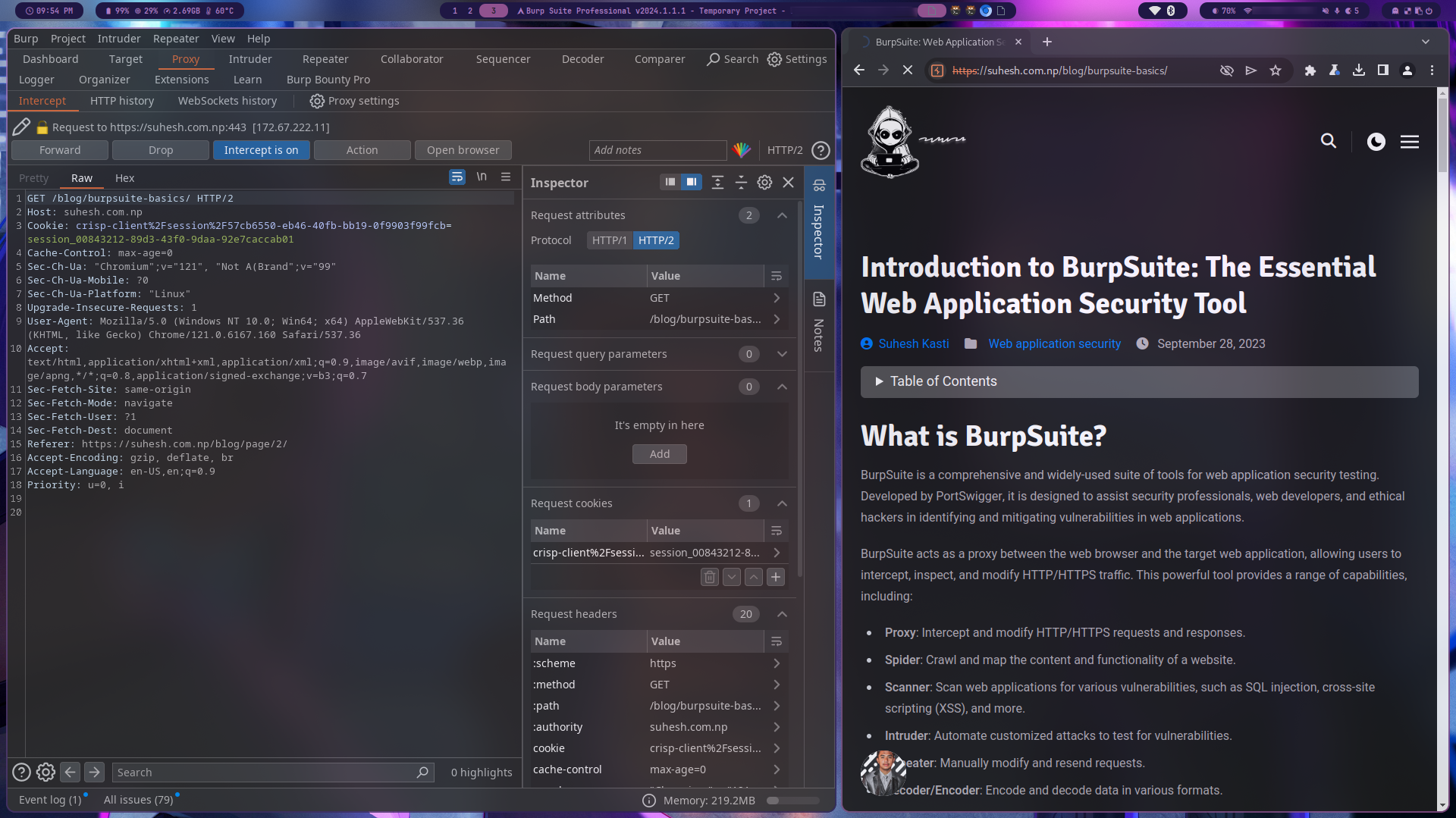
Navigate Content
BurpSuite: Part 1
Discover BurpSuite, a powerful tool for web application security testing, and learn about its features, use cases, and an open-source alternative called OWASP ZAP.
What is BurpSuite?
BurpSuite is a comprehensive and widely-used suite of tools for web application security testing. Developed by PortSwigger, it is designed to assist security professionals, web developers, and ethical hackers in identifying and mitigating vulnerabilities in web applications.
BurpSuite acts as a proxy between the web browser and the target web application, allowing users to intercept, inspect, and modify HTTP/HTTPS traffic. This powerful tool provides a range of capabilities, including:
- Proxy: Intercept and modify HTTP/HTTPS requests and responses.
- Spider: Crawl and map the content and functionality of a website.
- Scanner: Scan web applications for various vulnerabilities, such as SQL injection, cross-site scripting (XSS), and more.
- Intruder: Automate customized attacks to test for vulnerabilities.
- Repeater: Manually modify and resend requests.
- Decoder/Encoder: Encode and decode data in various formats.
- Sequencer: Analyze the randomness of session tokens.
- Comparer: Visually compare different application responses.
Installation
Visit the official Burp Suite website to download the appropriate version for your operating system.
Windows
In windows, you can simply download the installer and follow the installation wizard.
Alternately, burpsuite can also be installed in windows using winget. Open powershell and type the following the following command:
winget instal --id=PortSwigger.BurpSuite.Community -e
Linux
In most linux distritributions the user needs to download and extract the files from the website, then run the ./burpsuite_community script.
There might be available burpsuite’s native package in your distribution’s repositories. You can run the following command to search and install burpsuite directly from terminal. Just open the terminal and use the package manager according to the distribution:
For Debian/Ubuntu:
I did not find burpsuite in official Debian/Ubuntu repositories so you need to download and extract the files, then run the ./burpsuite_community script.
You can search in your distribution’s repository as it might have the package.
sudo apt search burpsuite
For Red Hat/CentOS/Fedora:
I did not find burpsuite in official Red Hat repositories so you need to download and extract the files, then run the ./burpsuite_community script.
You can search in your distribution’s repository as it might have the package.
sudo dnf search burpsuite
For Arch:
Burpsuite is not present in the official arch repository but it can be easily build and install it from Arch user repository using the command:
yay -Ss burpsuite
yay -S burpsuite OR
yay -S burpsuite-pro
Or you can also use chaotic aur where the community edition is already built.
macOS
macOS users need to download the installer, mount the disk image, and drag the Burp Suite application to your Applications folder. Or you can use the Homebrew package manager for a hassle-free installation:
brew install --cask burp-suite
Getting Started with Burp Suite
Launch Burp Suite: After installation, launch Burp Suite and familiarize yourself with the user interface.
Proxy Configuration: Set up your browser to use Burp Suite as a proxy. This enables the interception of web traffic.
Explore Modules: Navigate through different modules such as Proxy, Scanner, Repeater, Intruder, and Extender. Each module serves a specific purpose in the web application testing process.
Configuration: Customize settings, configure target scope, and explore various options within each module.
Documentation: Refer to the official documentation for in-depth information on Burp Suite’s features and functionalities.
Why Use BurpSuite?
BurpSuite is an essential tool for web application security professionals and developers for several reasons:
Comprehensive Security Testing: BurpSuite provides a wide range of tools and features that enable thorough security testing of web applications, from manual testing to automated vulnerability scanning.
Interception and Modification: The ability to intercept and modify HTTP/HTTPS traffic allows for in-depth analysis and manipulation of requests and responses, enabling advanced testing techniques.
Vulnerability Detection: BurpSuite’s powerful scanner can detect various types of vulnerabilities, such as SQL injection, XSS, insecure deserialization, and more, helping identify potential security risks.
Automation and Customization: The Intruder tool allows for automated and customized attacks, enabling efficient testing of web applications at scale.
Collaboration and Reporting: BurpSuite supports team collaboration and provides detailed reporting capabilities, making it easier to share and document findings.
Open-Source Alternative: OWASP ZAP
While BurpSuite is a commercial tool, there is an open-source alternative called OWASP ZAP (Zed Attack Proxy). OWASP ZAP is a free and open-source web application security scanner developed by the Open Web Application Security Project (OWASP) community.
OWASP ZAP offers similar functionality to BurpSuite, including:
- Proxy for intercepting and modifying HTTP/HTTPS traffic
- Web application crawler and spider
- Automated vulnerability scanning
- Support for various attack modes and payloads
- Integration with other security tools
While OWASP ZAP may not have the same level of advanced features and support as BurpSuite, it can be a viable option for individuals or organizations with limited budgets or those who prefer open-source solutions.
Note: Both BurpSuite and OWASP ZAP are powerful tools that should be used responsibly and with proper authorization. Unauthorized testing or exploitation of systems without permission is illegal and unethical.
In subsequent blog posts, we will dive deeper into specific features and use cases of BurpSuite, such as the Intruder tool, automated scanning, and more. Stay tuned for a comprehensive exploration of this essential web application security tool.
Word Quiz
Correct := 0 | Wrong := 0
Question?
Fill the Answer
Correct:= 0 | Wrong:= 0
Question